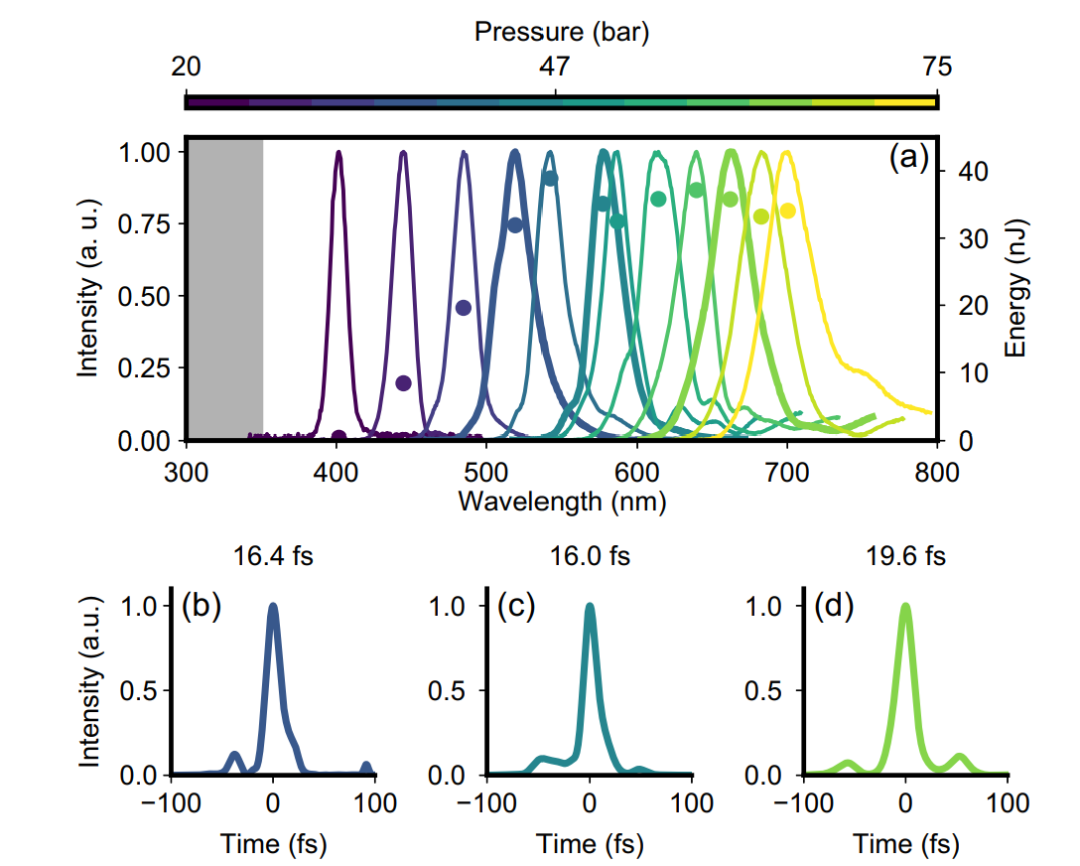Sub-20 femtosecond visible light tunable pulsed laser source
Recently, a research team from the UK published an innovative study, announcing that they have successfully developed a tunable megawatt-level sub-20 femtosecond visible light tunable pulsed laser source. This pulsed laser source, ultrafast fiber laser system is capable of generating pulses with tunable wavelengths, ultra-short durations, energies as high as 39 nanojoules, and peak power exceeding 2 megawatts, opening up brand-new application prospects for fields such as ultrafast spectroscopy, biological imaging, and industrial processing.
The core highlight of this technology lies in the combination of two cutting-edge methods: “Gain-Managed nonlinear Amplification (GMNA)” and “Resonant Dispersive Wave (RDW) emission”. In the past, to obtain such high-performance tunable ultrashshort pulses, expensive and complex titanium-sapphire lasers or optical parametric amplifiers were usually required. These devices were not only costly, bulky, and difficult to maintain, but also limited by low repetition rates and tuning ranges. The all-fiber solution developed this time not only significantly simplifies the system architecture but also greatly reduces costs and complexity. It enables the direct generation of sub-20 femtosecond, tunable to 400 to 700 nanometers and beyond high-power pulses at a high repetition frequency of 4.8 MHz. The research team achieved this breakthrough through a precisely designed system architecture. Firstly, they utilized a fully polarization-preserving mode-locked ytterbium fiber oscillator based on nonlinear amplification ring mirror (NALM) as the seed source. This design not only ensures the long-term stability of the system, but also avoids the degradation problem of physical saturated absorbers. After preamplification and pulse compression, the seed pulses are introduced into the GMNA stage. GMNA utilizes self-phase modulation and longitudinal asymmetric gain distribution in optical fibers to achieve spectral broadening and generate ultrashort pulses with nearly perfect linear chirp, which are ultimately compressed to sub-40 femtoseconds through grating pairs. During the RDW generation stage, researchers used self-designed and manufactured nine-resonator anti-resonance hollow-core fibers. This kind of optical fiber has extremely low loss in the pump pulse band and the visible light region, enabling the energy to be efficiently converted from the pump to the dispersed wave and avoiding the interference caused by the high-loss resonant band. Under the optimal conditions, the dispersion wave pulse energy output by the system can reach 39 nanojoules, the shortest pulse width can reach 13 femtoseconds, the peak power can be as high as 2.2 megawatts, and the energy conversion efficiency can be as high as 13%. Even more exciting is that by adjusting the gas pressure and fiber parameters, the system can be easily extended to the ultraviolet and infrared bands, achieving wideband tuning from deep ultraviolet to infrared.
This research not only holds significant importance in the fundamental field of photonics, but also opens up a new situation for the industrial and application fields. For instance, in fields such as multi-photon microscopy imaging, ultrafast time-resolved spectroscopy, material processing, precision medicine, and ultrafast nonlinear optics research, this compact, efficient, and low-cost new type of ultrafast light source will provide users with unprecedented tools and flexibility. Especially in scenarios that require high repetition rates, peak power and ultra-short pulses, this technology is undoubtedly more competitive and has greater promotion potential compared to traditional titanium-sapphire or optical parametric amplification systems.
In the future, the research team plans to further optimize the system, such as integrating the current architecture that contains multiple free-space optical components into optical fibers, or even using a single Mamyshev oscillator to replace the current oscillator and amplifier combination, in order to achieve the miniaturization and integration of the system. In addition, by adapting to different types of anti-resonance fibers, introducing Raman active gases and frequency doubling modules, this system is expected to be expanded to a wider band, providing all-fiber, wideband, ultrafast laser solutions for multiple fields such as ultraviolet, visible light and infrared.

Figure 1. Schematic diagram of the tuning of the pulsed laser
Post time: May-28-2025





